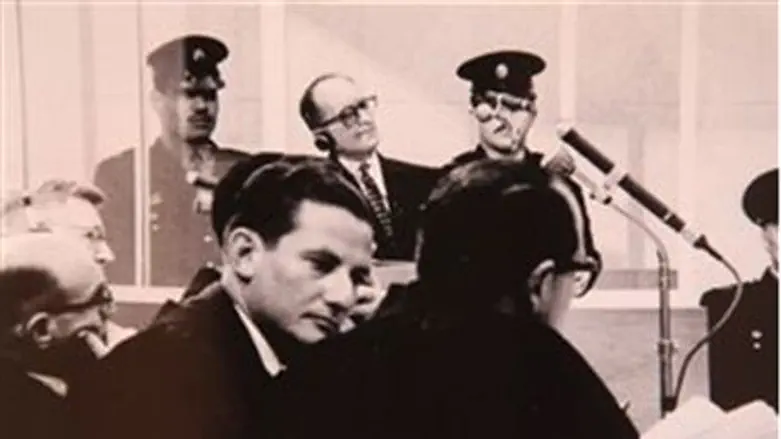
On Monday, exactly 50 years to the day the Eichmann Trial began in Israel, Yad Vashem opened a new exhibition on the trial.
The exhibition, entitled “With Me Here Are Six Million Accusers: An Exhibition Commemorating the 50th Anniversary of the Eichmann Trial”, will be on display in Jerusalem and was produced by Yad Vashem’s Museums Division. The exhibition focuses on visual aspects of the event, based on the unique items found in Yad Vashem’s collections, the National Archive, and the National Photographic Collection. The exhibition displays original footage from the filming of the trial, and various additional media productions that allow visitors to get a sense of the trial as it occurred.
“This exhibition has a very very clear message,” said the exhibition’s academic advisor, Gideon Greif, at a special media preview of the exhibition which took place on Sunday, one day before it was opened to the public. “It demonstrates that Adolf Eichmann was not what he claimed during the trial in Jerusalem. He was not the man behind the desk. He was a very active murderer. He went to the sites to which he sent the Jews. He wanted to see if his orders are functioning. He was not willing to relieve even one Jew.”
Curator Yehudit Shendar said that it is important for the exhibition to take place in Jerusalem because Israel was the only state that was determined to put Eichmann on trial for his crimes. Since the trial took place in Jerusalem’s Beit Ha’am, it is only natural, said Shendar, that the exhibition be displayed there.
Shendar also mentioned the important role played by Yad Vashem during the Eichmann Trial.
“When Bureau 06 was opened in order to assist the prosecution with preparing the material for the trial, it was Yad Vashem they turned to in order to get documents and photographs,” she said. “The charge which Yad Vashem took upon itself to collect everything that has to do with the Holocaust came to fruition at that very moment.”
Yad Vashem, said Shendar, was also helpful in providing witness to the Eichmann Trial because by that time it had hundreds of names of witnesses who told their stories to Yad Vashem.
“Yad Vashem provided the list of witnesses for the prosecution,” said Shendar. “Now and then, Yad Vashem still plays an essential role in commemorating, remembering and teaching [the Holocaust].”
Adolf Eichmann, one of the major planners of the Holocaust genocide, was put on trial in Israel in 1961, after having been captured by Israeli agents in Argentina. He was found guilty, and was put to death in 1962.
The exhibition was launched a day after Yad Vashem uploaded footage of the entire trial to YouTube for the purpose of giving “a new generation the opportunity to view one of the most significant turning points in humanity’s attempt to grapple with the Holocaust.”
Yad Vashem has also announced the launch of “Operation Pick Up the Pieces”, a national campaign aimed at saving personal items from the Holocaust.
As part of the campaign, Yad Vashem officials hope to collect documents, certificates, diaries, photographs, artifacts and artwork from the Holocaust, which are currently in the hands of private individuals throughout Israel.